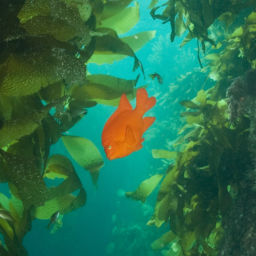By John Heimann
From the southern Channel Islands to Northern Baja, giant kelp reigns supreme. Growing from 10 to 24 inches per day, depending on conditions, the giant kelp forests off the Southern California coast are one of the strongest known ecosystems on the planet, and play host to hundreds of different marine species. Unlike most topside forests, kelp does not grow out of the substrate; rather, its root system (or stronghold) latches onto the rocky, coastal bottom where there is plenty of sunlight to promote its rapid growth. Giant kelp thrives in the nutrient rich, cold, clear waters of the eastern Pacific, and has an average lifespan of 5 to 7 years depending on currents and surf conditions. Its dense canopy and stalks offer a cozy home for many types of fish, nudibranchs, snails and even bat rays. Many marine mammals such as seals, sea lions, otters — and even the occasional gray whale — have been known to seek refuge in the giant kelp forests for protection from nearby apex predators. All of this scientific mumbo-jumbo aside, diving the incredible giant kelp forests along the California coast and Channel Islands should be on every diver’s bucket list.
If you do plan to dive the giant kelp, you can choose almost any beach along the California coastline, but the most popular dive destination is Catalina Island. Featured in a previous article, enough can’t be said about the beauty of this incredible place. Whether you plan to visit the dive park or boat dive along the eastern side of the island, the conditions are almost always perfect for the kelp to grow in abundance. Have a plan in place before you venture in, as it is very easy to become separated from your buddy in this dense environment. Stick close together and have your knife handy just in case you must cut yourself out of a sticky situation. Most dives include plentiful sightings of garibaldi, sheepshead, moray eels, scorpionfish, nudibranchs — the list goes on. You’ll be amazed at the vast expanse of this submarine forest, but be sure to take the time to marvel at its tiny details as well.


